I had breakfast on a hill overlooking the lake, surveying all my domain around me; I had the whole area to myself. The campsite also had showers; bliss.
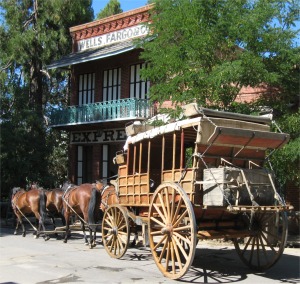
Wells Fargo Bank
|
The Columbia State Historic Park was a few miles back down the 49, so I headed off to see what it had to offer. The park lay amidst the rugged, rocky oak woodlands of the Sierra Nevada foothills, a living historic town featuring the state's largest collection of gold rush-era brick buildings. The search for gold in the foothills offered hope and, for a fortunate few, riches. It drew prospectors from all over the world and of every nationality, including California Indians. Besides digging and panning for gold, they bought, sold and traded to try and make their fortune.
On 27th March, 1850, a group of prospectors discovered gold there. Passing through this area, Dr. Thaddeus Hildreth, his brother George, John Walker and others were caught in a rainstorm. While drying out their gear, Walker decided to try his luck in the nearby gulch. Within six weeks his findings attracted thousands of miners. Their crowded camp of log cabins and canvas tents, known as Hildreth's Diggings, was formally renamed Columbia on 29th April, 1850. By 1852 more than 150 stores, shops, saloons and other business enterprises were operating in Columbia. The town also boasted three churches, a meeting hall, a Masonic Lodge and a branch of the Sons of Temperance.
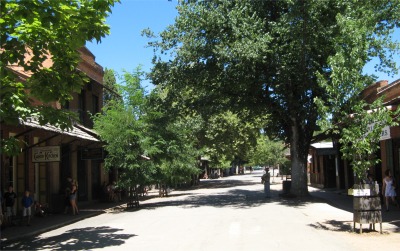
Columbia Main Street
|
Water was essential for placer mining (panning and dredging for gold). High water rates from the Tuolumne County Water Company forced the miners to build their own 60 mile aqueduct, known as the Miner's Ditch, to supply water more cheaply. The importance of water was realised after a fire in 1854 destroyed six city blocks leaving only brick buildings. The town was quickly rebuilt using locally-produced red bricks.
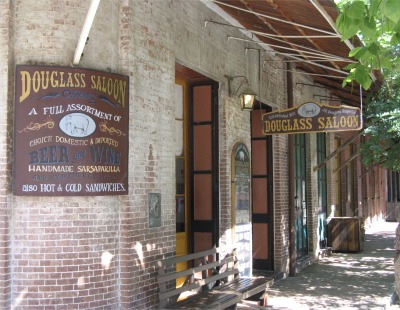
Douglass Saloon
|
With improved water delivery to Columbia, miners began to employ more efficient mining methods in their quest for gold. In some places, open pit placer mining operations removed more than sixty feet of dirt and washed it through a system of sluices to remove the gold. Using water power, the miners hoisted gravel from deep placer deposits to higher ground, where it could be processed using hydraulic methods. The result of their efforts left expansive limestone formations visible in the main car park.
By 1853 Columbia was one of the largest cities in California, with an estimated population of 25,000. Between 1850 and the early 1900s, as much as $150M in gold was mined there. Gold from Columbia helped to finance the US government and the Union Army during the Civil War. As mining dwindled in the late 1860s, Columbia began to decline.
While Columbia never became a ghost town, by the 1940s the buildings had deteriorated to the point that many were considered unsafe. When Columbia became a state park in 1945, restoration efforts began on the 150 year old structures to capture and preserve their historic value. Today, Columbia State Historic Park contained the largest single collection of existing gold rush-era structures.
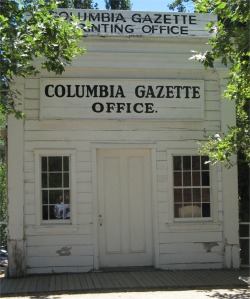
Columbia Gazette Office
|
|
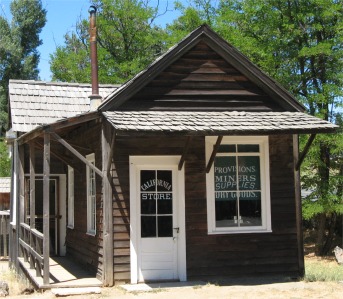
A Converted Saloon
|
|
I joined a guided tour trip around the historic town. The guide was very knowledgeable (those volunteers had to undergo six weeks of training) and he had an endless supply of anecdotes and jokes. He also had a habit of pausing after each one for audience feedback; at times he was clearly disappointed since he got none, but he bit his tongue.
He mentioned that people invariably asked where the gold mine was, he had to reply by saying they were standing on it. The gold sat at the boundary between the upper soil and gravel, and the bedrock.
Many movies and commercials had been made in the town. I stood in the Wells Fargo exactly where Clint Eastwood once stood, and I touched the fourth picket of a gate that Gary Cooper once touched, not that it meant a lot to me. Apparently on a regular basis, the fourth picket disappeared. It doesn't happen anymore nowadays since current generations don't even know who he was.
It must have been a rowdy place during those times, full of miners who wanted three things out of life: beer, gambling and women.
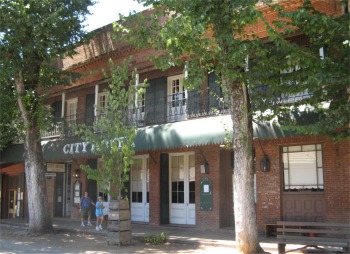
City Hotel
|
The guide related a story about the Chinese community of the time (he carefully checked that the three Oriental ladies were Japanese and not Chinese). They had been ostracised to a separate camp because they were in a minority and were also accused of starting the fires that burned down the buildings. A power struggle had been brewing between two Chinese gangs as to who should have control over the Chinese interests. To resolve the issue, they had arranged to do battle, and the blacksmiths were doing a roaring trade in swords, spears and shields. When it came to the day of the battle, all the miners decided to go and watch for the entertainment value, and also to gamble on the outcome. Well the Chinese gangs charged each other, then retreated with no sign of injury. They launched into another charge, and retreated again with just a few injuries. The miners were disappointed in this process, and started firing guns at the Chinese to liven up the proceedings.
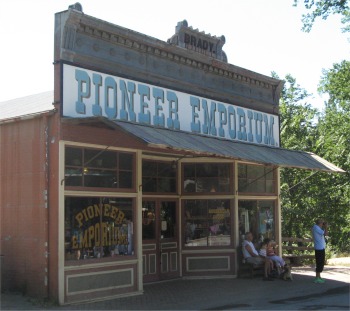
Pioneer Emporium
|
Now what was interesting was that when the guide made his usual pause for any feedback, I could sense unease in the Americans. The pause lengthened into a gaping Grand Canyon, and for some reason he held it. Eventually a few brave souls tried to justify it by saying that was how it was in those days, which was probably exactly how it was. There was no counter argument, and folk seemed glad when he moved on to the next topic. It had clearly rattled some of our chums since they dropped out of the tour. An interesting psychological experiment .
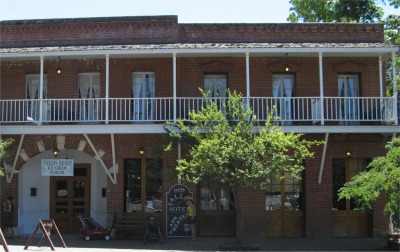
Fallon Hotel and Theatre
|
The whole area reminded me of the Beamish Museum in the northeast of England, the sort of place where you visit in a couple of hours, or spend a couple of hours in every building.
After the tour, I visited one of the saloons to try a sarsaparilla. I sat at the ancient bar, and a chap came in and sat nearby. He clearly knew the bartender. An older chap came in, greeted the other guy, and ordered his beer. I got chatting to the older chap, who seemed a bit cantankerous at times with a two man band playing in the corner. He had fought in Korea, and got to know many Brits out there. He reeled off one story after another. Then his wife came in, and she told me jokes that were rather risqu�. I soon discovered that a lot of locals came across to the historic town to meet up and use the bars and restaurants. I really enjoyed their company, and stayed longer than I planned to.

Jackson Main Street
|
Eventually I left this exceedingly well preserved and interesting gold town, and continued my journey north up the 49. I stopped off at Jackson and had a walk down its main street. It too had its fair share of preserved historic buildings.
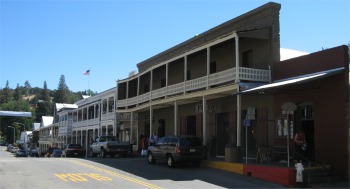
Sutter Creek
|
|
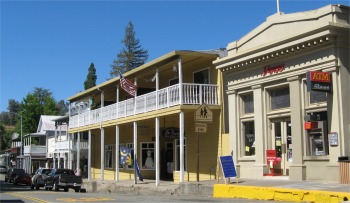
Sutter Creek Again
|
|
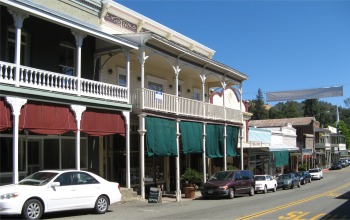
Once Again Sutter Creek
|
|
A short distance further on I pulled into Sutter Creek which had survived unchanged since the gold rush. Named after John Sutter, this scenic town grew up to service the Old Eureka Mine, owned by Hetty Green, the "richest woman in the world". This town too had an impressive collection of mid 19th century buildings.
The Co-op art gallery caught my attention and in I went and got chatting to the guy at the desk. He was amazed to find a non-American travelling up the Gold Country; most folk just headed to the big cities. The chap mentioned about underground gold mine tours just up the road, so I quickly bade farewell and shot up to the mine to catch the next available tour.
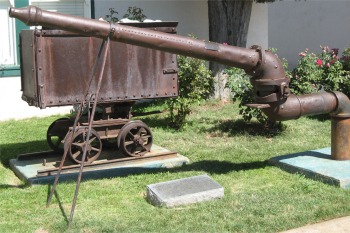
Ore Tub and Water Canon
|
The tour was in driven open wagons down a long drift mine, eventually taking us 500' below the surface, though the mine continued far deeper. The mine was in a hard rock, with veins of quartz running through it. Gold existed within the quartz.
The mine had stopped working in 1992 because the drop in gold prices had made it no longer financially viable. However, a South African consortium had bought the mine after promising surveys had been conducted, and were going through all the Californian bureaucratic processes to start it up again.
The mine was much developed when pneumatic drill were being introduced. This may have seemed like a bonus to the miners. However, the result was that those miners who drilled the quartz usually died of silicosis within three years, and all other miners drilling into rock were deaf within five years. Grim times indeed. It had been a very enjoyable tour down the mine.
From there I headed up to Coloma to locate a campsite for the night. A store put me onto one, which turned out to be classified as a resort, and was pricy. I protested, and the woman took pity on me and took 25% off the price. It sometimes paid to haggle.













